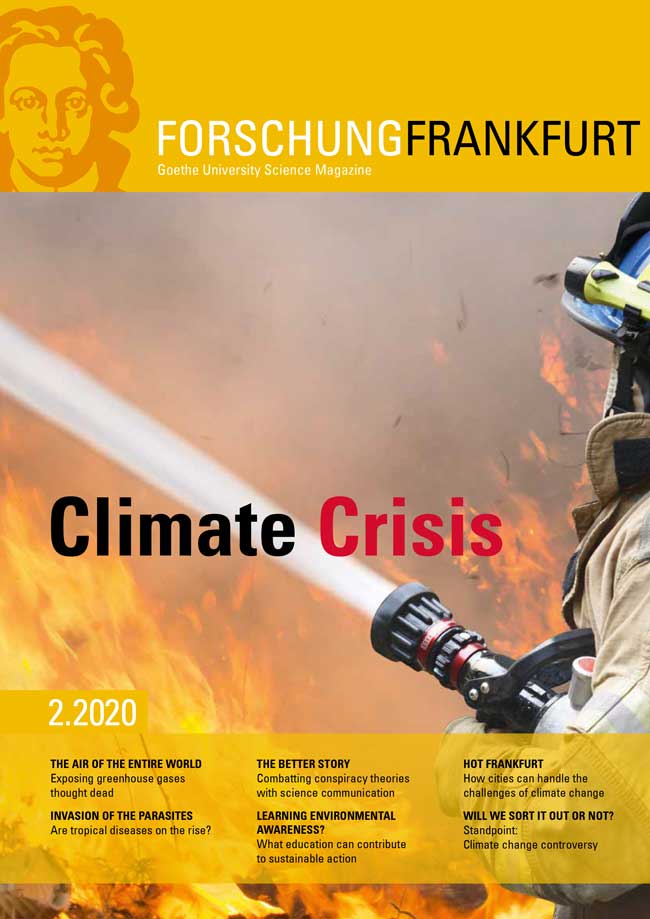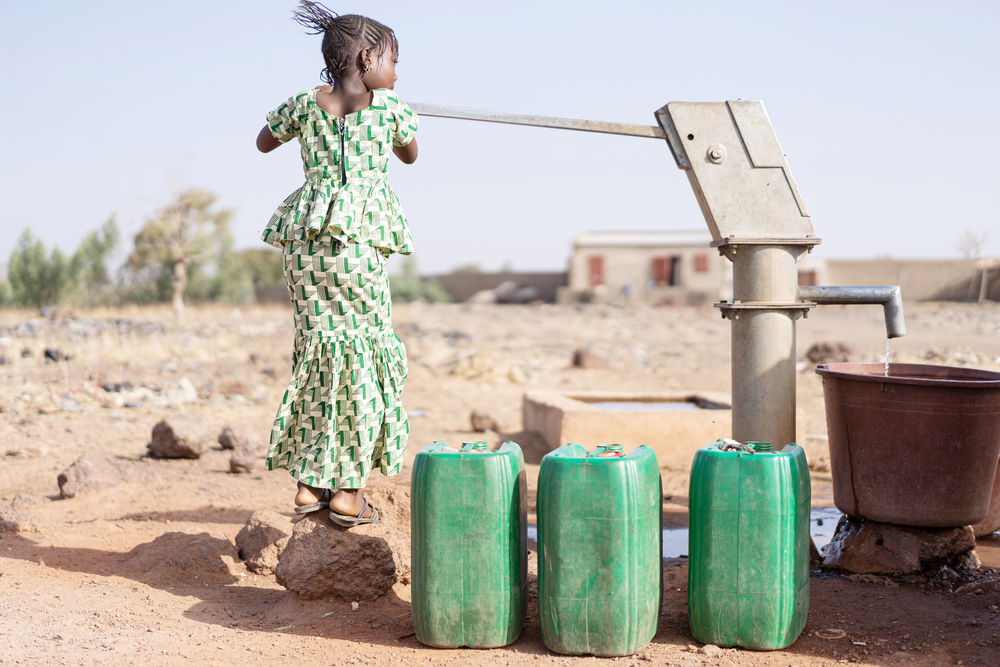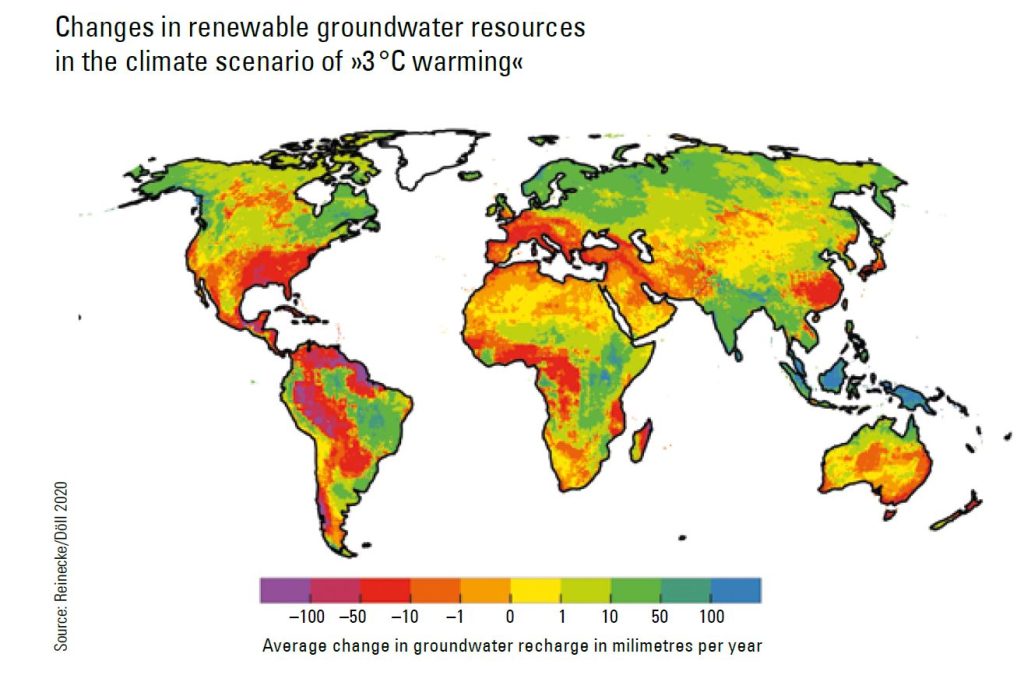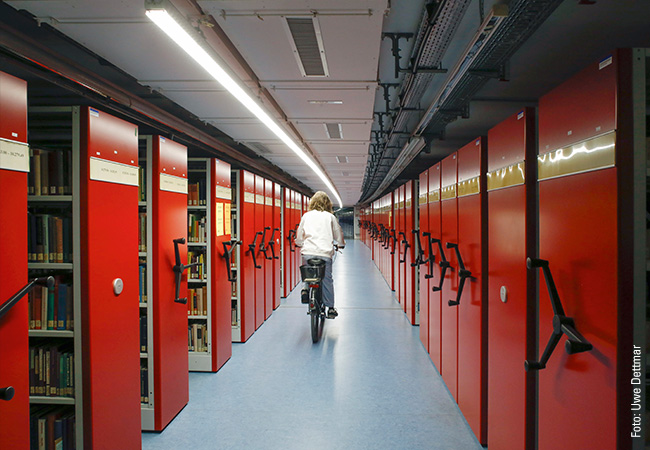
In March 2023, the United Nations convened its first Water Conference in 46 years. There is a dire need for action: as a result of climate change, water is threatening to become increasingly scarce in many places, while other regions are suffering from flooding. Freshwater accounts for just about 3 percent of the world’s water – and only a tenth of that is accessible via rivers and lakes. That is why in many regions, people obtain their water from groundwater. Scientists led by Prof. Petra Döll of Goethe University have investigated how climate change affects the reconstitution of groundwater. They reported on their international groundwater study in the 02/2020 „Climate Crisis“ edition of Forschung Frankfurt.
Forschung Frankfurt (2/2020, Klimakrise)
During drought periods vegetable fields like this in the Netherlands need to be irrigated. Often, the water is taken from ground water wells.
The source of life
How climate change affects global groundwater levels
Groundwater could become scarce in many regions around the world as climate change progresses. This is clear from a large international study initiated by the geographer Petra Döll and the doctoral researcher Robert Reinecke. Water shortages may arise or become more severe in many locations. Other regions are likely to struggle with rising groundwater levels. Cultivable land could become waterlogged.
Groundwater is a vital resource. In many countries, it is the principal source of drinking water. Pumping groundwater upwards from deep wells also enables fields to be irrigated and cereals, fruit and vegetables to be grown in arid regions. Despite its great importance, groundwater was largely ignored by many people in Central Europe for a long time because supplies were generally adequate. The extremely arid summers seen in the past three years have, however, kindled fears that water could become scarce as the climate becomes warmer.
Professor Petra Döll, the geographer who heads the Hydrology Research Group at Goethe University, was already interested in groundwater well before this more recent discussion took off. Döll is something of an exotic rarity among her hydrologist colleagues, as she comments: »Hydrologists are typically interested in studying streams and rivers, in looking at surface water«. Groundwater and the hazards climate change presents for it only became a major issue in recent years. Sustainable groundwater resources could decline in many areas, threatening the supply of water to agriculture, industry and households, as climate change progresses.
Too much here, not enough there
Droughts and sinking groundwater levels are by no means the only problems. Rising groundwater levels are also a likely hazard. Experts expect precipitation to increase in some regions due to climate change. This could raise groundwater levels. »In some parts of Germany«, Petra Döll explains, »the groundwater is only two or maybe five metres below the surface. If the water table rises, areas under cultivation could become waterlogged and agriculturally used areas could be lost. Cellars would need costly protection against groundwater leaking in. Any deviations from what is normal now – both rising and sinking groundwater levels – could cause issues.«
Together with the doctoral researcher Robert Reinecke and cooperation partners from research institutes in Belgium, Japan, the Netherlands and many other countries, Petra Döll has recently looked into the future. In a complex study, the researchers drew on global hydrological models that calculate groundwater recharge on the Earth’s entire terrestrial surface to determine the regions that could be affected by sinking or rising groundwater levels in the future. This involved a huge amount of work, since the international team drew on and combined the results of multiple hydrological models that were in turn driven by various climate scenarios derived by multiple climate models.
This study would not have been possible without the major international ISIMIP project coordinated by the Potsdam Institute for Climate Impact Research (PIK). More than a hundred groups of researchers involved in ISIMIP are modelling the impact of anthropogenic climate change could have by the end of the current century, not only on water resources, but also, for example, on vegetation and crop yields. As nobody today can say how greenhouse gas emissions will change over the coming decades because of climate protection measures, researchers of the ISIMIP project are modelling four different scenarios that correspond to the emissions scenarios of the Intergovernmental Panel on Climate Change. These range from a strong reduction in greenhouse gas emissions to the grim scenario that emissions continue to rise at the current rate. For each of the four emissions scenarios, four different climate scenarios calculated by four global climate models are available.

Unique combination of climate data and groundwater expertise
The groundwater experts have now linked the climate scenarios provided by the ISIMIP project – the expected future CO2 , precipitation and temperature values – with eight different global hydrological models. One challenge that presented itself was that the global hydrological models reach their results in quite different ways. Some consider vegetation changes attributable to climate change while others do not, for example. The results of the eight different global hydrological models differ starkly as a result – vegetation, after all, has considerable influence on evapotranspiration and thus also on groundwater recharging. »Plants transpire water into the atmosphere. And plants, especially forests, also capture and store water in the ground«, Petra Döll says. The models yielded highly divergent results for several world regions including South-East Asia. While it seems relatively clear to climate researchers that monsoon rainfall in India will increase because of climate change, the groundwater models cannot give clear and solid predictions on how this will affect groundwater.
Water shortages in the Mediterranean Basin and Northeast Brazil
In other parts of the world, as Petra Döll reports, the study yielded unambiguous results – vegetation or no vegetation. The data show that groundwater recharge is likely to decline in two regions that are already affected by water shortages today, the Mediterranean Basin and Brazil’s dry northeastern region. »Many people associate Brazil with the perpetually moist Amazon rainforest. But there are areas close to the equator that are already hot and dry today. Both in Northeast Brazil and the entire Mediterranean region, climate change is likely to exacerbate existing water shortages with negative consequences in particular for agriculture.« Sinking groundwater levels can lead to several problems. Pumping wells constructed at great expense could run completely dry. Even deeper wells could be bored to reach deeper groundwater layers, but the availability of groundwater at these deeper levels could also gradually decline over time if less and less groundwater is replenished. »The overuse of groundwater is a known problem«, Petra Döll explains. »To conserve natural aquifers, it is important to remove less water than can be replaced by groundwater recharge. Removing the same quantity of water as the amount that can be replaced by recharging is already a no-go because that does not leave any water for habitats, rivers or the vegetation.«
Sinking groundwater levels could also become a problem for the Amazon rainforest. It does not rain all year round there, as many people think; rainy periods and dry periods alternate. If groundwater levels sink so much that the trees can no longer reach water with their deep roots during dry periods, parts of the forest could die back. That would be a further burden for a rainforest already under pressure from logging and forest fires.

Water shortages in the Mediterranean Basin and Northeast Brazil
In other parts of the world, as Petra Döll reports, the study yielded unambiguous results – vegetation or no vegetation. The data show that groundwater recharge is likely to decline in two regions that are already affected by water shortages today, the Mediterranean Basin and Brazil’s dry northeastern region. »Many people associate Brazil with the perpetually moist Amazon rainforest. But there are areas close to the equator that are already hot and dry today. Both in Northeast Brazil and the entire Mediterranean region, climate change is likely to exacerbate existing water shortages with negative consequences in particular for agriculture.« Sinking groundwater levels can lead to several problems. Pumping wells constructed at great expense could run completely dry. Even deeper wells could be bored to reach deeper groundwater layers, but the availability of groundwater at these deeper levels could also gradually decline over time if less and less groundwater is replenished. »The overuse of groundwater is a known problem«, Petra Döll explains. »To conserve natural aquifers, it is important to remove less water than can be replaced by groundwater recharge. Removing the same quantity of water as the amount that can be replaced by recharging is already a no-go because that does not leave any water for habitats, rivers or the vegetation.«
Sinking groundwater levels could also become a problem for the Amazon rainforest. It does not rain all year round there, as many people think; rainy periods and dry periods alternate. If groundwater levels sink so much that the trees can no longer reach water with their deep roots during dry periods, parts of the forest could die back. That would be a further burden for a rainforest already under pressure from logging and forest fires.
Important insights for adaptation measures
As Petra Döll, the initiator and coordinator of the international study, emphasises, »Global climate data and a wide variety of models simulating groundwater recharge processes have never been combined in this way before. Our work thus provides a solid basis for policy interventions – for projects and initiatives that enable people in the areas affected to prepare for the impact of climate change in time.« More efficient irrigation methods could be used, for instance, or the areas under irrigation reduced.
The study results are also relevant for regions where different models produce quite divergent results on future changes in groundwater levels. »Let us say that we have an overall prediction that a region’s groundwater recharge is expected to decline by between 10 and 40 per cent. A highly risk-averse approach would be to implement water management measures that make it possible to live with a decline of 40 per cent. Policy-makers who are willing to tolerate more risk could initiate measures designed to adapt to a 10 per cent decline.«

Prof. Dr. Petra Döll, born in 1962, studied geology at the Universities of Erlangen and Colorado and earned a Master of Science focused on geohydrology from the University of Colorado. She subsequently worked in the Geological Survey at the Ministry of Urban Development and the Environment in Hamburg and went on to complete a doctoral degree in soil science at TU Berlin. She gained her habilitation (venia legendi) in Environmental Systems Analysis from the University of Kassel and has been a Professor for Hydrology at the Institute of Physical Geography at Goethe University since 2003. p.doell@em.uni-frankfurt.de
The Author
Tim Schröder, born in 1970, studied biology with ocean physics as a minor, worked as a trainee journalist at the newspaper NordwestZeitung and then as a science editor at the Berliner Zeitung. He has been working as a freelance journalist specialising in the natural sciences, energy and the environment since 2001. kontakt@schroeder-tim.de













